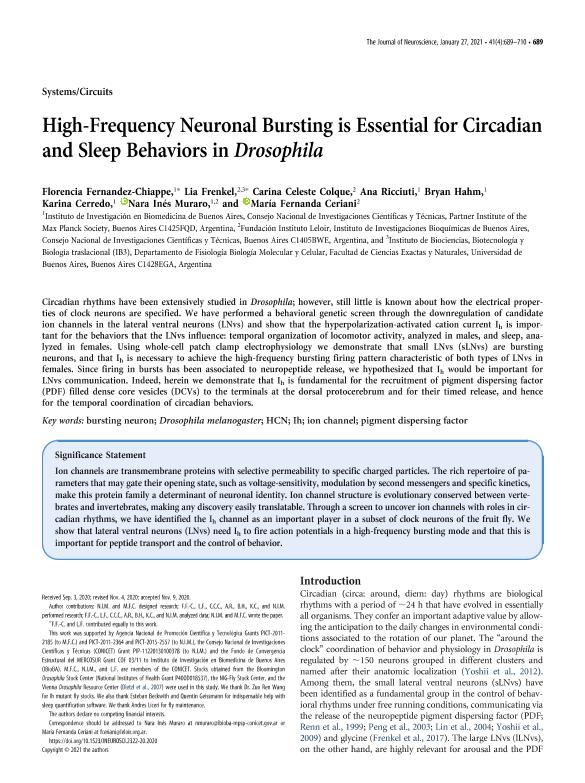Artículo
High-frequency neuronal bursting is essential for circadian and sleep behaviors in drosophila
Fernández, Florencia ; Frenkel, Lia
; Frenkel, Lia ; Colque, Carina Celeste
; Colque, Carina Celeste ; Ricciuti, Ana; Hahm, Bryan; Cerredo, Karina; Muraro, Nara Ines
; Ricciuti, Ana; Hahm, Bryan; Cerredo, Karina; Muraro, Nara Ines ; Ceriani, Maria Fernanda
; Ceriani, Maria Fernanda
 ; Frenkel, Lia
; Frenkel, Lia ; Colque, Carina Celeste
; Colque, Carina Celeste ; Ricciuti, Ana; Hahm, Bryan; Cerredo, Karina; Muraro, Nara Ines
; Ricciuti, Ana; Hahm, Bryan; Cerredo, Karina; Muraro, Nara Ines ; Ceriani, Maria Fernanda
; Ceriani, Maria Fernanda
Fecha de publicación:
01/2021
Editorial:
Society for Neuroscience
Revista:
Journal of Neuroscience
ISSN:
0270-6474
Idioma:
Inglés
Tipo de recurso:
Artículo publicado
Clasificación temática:
Resumen
Circadian rhythms have been extensively studied in Drosophila; however, still little is known about how the electrical properties of clock neurons are specified. We have performed a behavioral genetic screen through the downregulation of candidate ion channels in the lateral ventral neurons (LNvs) and show that the hyperpolarization-activated cation current Ih is important for the behaviors that the LNvs influence: temporal organization of locomotor activity, analyzed in males, and sleep, analyzed in females. Using whole-cell patch clamp electrophysiology we demonstrate that small LNvs (sLNvs) are bursting neurons, and that Ih is necessary to achieve the high-frequency bursting firing pattern characteristic of both types of LNvs in females. Since firing in bursts has been associated to neuropeptide release, we hypothesized that Ih would be important for LNvs communication. Indeed, herein we demonstrate that Ih is fundamental for the recruitment of pigment dispersing factor (PDF) filled dense core vesicles (DCVs) to the terminals at the dorsal protocerebrum and for their timed release, and hence for the temporal coordination of circadian behaviors.
Archivos asociados
Licencia
Identificadores
Colecciones
Articulos(IBIOBA - MPSP)
Articulos de INST. D/INV.EN BIOMED.DE BS AS-CONICET-INST. PARTNER SOCIEDAD MAX PLANCK
Articulos de INST. D/INV.EN BIOMED.DE BS AS-CONICET-INST. PARTNER SOCIEDAD MAX PLANCK
Articulos(IIBBA)
Articulos de INST.DE INVEST.BIOQUIMICAS DE BS.AS(I)
Articulos de INST.DE INVEST.BIOQUIMICAS DE BS.AS(I)
Citación
Fernández, Florencia; Frenkel, Lia; Colque, Carina Celeste; Ricciuti, Ana; Hahm, Bryan; et al.; High-frequency neuronal bursting is essential for circadian and sleep behaviors in drosophila; Society for Neuroscience; Journal of Neuroscience; 41; 4; 1-2021; 689-710
Compartir
Altmétricas



